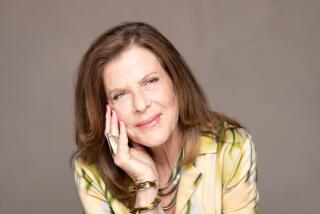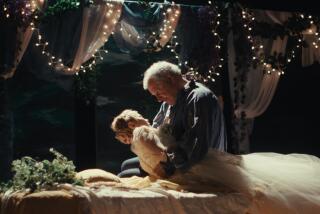Design for User: Credo of Luckman Partner
- Share via
Michael J. O’Sullivan has been blessed with the luck of the Irish.
Part of that good fortune, he said, is his recent appointment as partner in charge of design for the Luckman Partnership, which also makes him the first architect to join that organization as a full partner.
He joined partners James M. Luckman, Richard A. McKnew and Frederick M. Yerou, and allied himself to an impressive body of architectural work of the 37-year-old firm. Projects include the Warner Bros. offices in Burbank, the North Orange County Civic Center, the Hyatt Regency Hotel in Los Angeles, Arco Center in Long Beach and Century Park East condominiums.
For O’Sullivan, the personal rewards of his profession have been derived from opportunities to create “wonderfully workable structures” in association with a number of the nation’s most prestigious architectural firms.
University Projects
His first major job, in the mid-’60s, was with the architectural firm of Powell, Morgridge, Richards & Coughlan, which specialized in the design of schools and colleges. Projects designed by O’Sullivan for the firm included the North Hall Classroom Office Building and the South Hall Graduate Tower at UC Santa Barbara.
“Those assignments provided my first contact with the Luckman organization, the master planner for the university,” he said.
For 20 years, until he joined the Luckman Partnership last May, O’Sullivan was associated with Albert C. Martin & Associates, serving since 1981 as that firm’s director of design.
While with the Martin firm, O’Sullivan worked on the designs of 30 or more buildings, including the 370,000-square-foot western home office for Prudential Insurance Co. of America in Westlake Village, and the Parker-Hannifin aerospace complex in Irvine, both winners of AIA design awards.
Other projects included the General Telephone Lakeview Building in Thousand Oaks, a 75-story tower concept study for Raffi Cohen International and the Manulife Tower at 9th and Figueroa streets for Manufacturers Life, a 38-story office building in the construction documents stage.
Social Obligation
O’Sullivan received special commendations for his participation on the American Institute of Architects Olympics/84 Committee and for initiating and chairing the 1975 energy task force of the California Council of the AIA.
He believes architects have a social and spiritual obligation to recognize that everyone has a stake in the environment and that “good architecture should satisfy the needs of all.” Born in Los Angeles in 1935, he grew up in the Hollywood Hills “at a time when there was much more distance between homes.”
Architects have been lured to their profession along different paths. For O’Sullivan, the calling grew out of his fascination for aviation, particularly for helicopters.
Aptitude for Design
While still in the Army he began to research applications of helicopter technology for civilian use, and in because of his aptitude for design, was encouraged to study architecture.
O’Sullivan worked at several jobs to help pay his tuition at USC’s School of Architecture and “was lucky to land a job with Howard Morgridge two days after graduation.”
Any disappointments along the way?
“I have been pretty sheltered from disappointment. I take things as they come and feel I am strong enough to deal with super egos, when necessary. It is important for an architect to maintain an active dialogue with clients so that their ideas may influence his thinking and, in turn, answer their needs,” O’Sullivan said.
“But I have also been around long enough to know that the individual in charge may be gone by the time the building is completed. Ultimately, it is the building that matters . . . that it has to be greater and bigger than any of us.”
Planning for Flexibility
How a building can best function for its users is a priority that must always exist, he said. “A critical question the architect must deal with is: Does the building have long-range flexibility? And, can I get a client to understand that probably a great deal of his investment needs hinge on the ability of the building to adapt?”
O’Sullivan does not consider himself a follower of trendy styles. “The much-publicized Post-Modernism was a natural progression in reaction to too many formless all-glass boxes that had no definition to their entrances and no grace in dealing with the quality of light,” he said.
“Many, like myself, were concerned about the pastiche of some of the Post-Modern efforts, for in many ways, things were sort of tossed onto building. But there is no doubt that we owe the Post-Modern era a great debt for ringing the bell. . . . We’ve gone too far with this wonderful envelope material called glass.” The question of natural light in a building is a dominant consideration, maintains O’Sullivan, who has been a consultant to the Southern California Edison Co. for several years.
Importance of Light
“Nowadays, with what we have learned about the energy aspect of architecture and with all the technology that enables us to balance the energy and moderate the quality of light, I go out of my way to bring it into a building,” he added.
O’Sullivan spoke of experiments with the deflection of light, the balance of cool and warm light and how varied its applications can be within a building.
“In a sense we can actually stage the work environment with light, sometimes by creating series of interior streets and an atrium as connectors to giant wings of work space, and then, with electronically positioned louvers, to orchestrate the pattern and level of natural light,” he said.
‘Bizarre Field’
O’Sullivan looks forward to a contemporary renaissance in his field. “As architects, when we tend to moan and groan about what a crazy business this is, I hope we never relinquish our part in the great vision.
“You can have clients who inspire support for your ideas, engineers who make them possible, but if you haven’t cared enough to immerse yourself for a time and let that vision come forward, you should step back and let others do it.
“It’s a bizarre field at its best, but what other possible occupation would allow an individual to embrace the science of engineering and enfold the dignity of sculpture and art into a building that is to remain for a hundred years, then walk away and leave that as his legacy to society? What a deal, if you can do it right!”
More to Read
The biggest entertainment stories
Get our big stories about Hollywood, film, television, music, arts, culture and more right in your inbox as soon as they publish.
You may occasionally receive promotional content from the Los Angeles Times.










